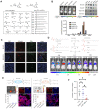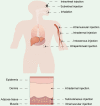Targeting materials and strategies for RNA delivery
- PMID: 37649616
- PMCID: PMC10465230
- DOI: 10.7150/thno.87316
Targeting materials and strategies for RNA delivery
Abstract
RNA-based therapeutics have shown great promise in various medical applications, including cancers, infectious diseases, and metabolic diseases. The recent success of mRNA vaccines for combating the COVID-19 pandemic has highlighted the medical value of RNA drugs. However, one of the major challenges in realizing the full potential of RNA drugs is to deliver RNA into specific organs and tissues in a targeted manner, which is crucial for achieving therapeutic efficacy, reducing side effects, and enhancing overall treatment efficacy. Numerous attempts have been made to pursue targeting, nonetheless, the lack of clear guideline and commonality elucidation has hindered the clinical translation of RNA drugs. In this review, we outline the mechanisms of action for targeted RNA delivery systems and summarize four key factors that influence the targeting delivery of RNA drugs. These factors include the category of vector materials, chemical structures of vectors, administration routes, and physicochemical properties of RNA vectors, and they all notably contribute to specific organ/tissue tropism. Furthermore, we provide an overview of the main RNA-based drugs that are currently in clinical trials, highlighting their design strategies and tissue tropism applications. This review will aid to understand the principles and mechanisms of targeted delivery systems, accelerating the development of future RNA drugs for different diseases.
Keywords: RNA-based therapeutics; Specific organ/tissue tropism; Targeting materials; Targeting strategies; mRNA delivery.
© The author(s).
Conflict of interest statement
Competing Interests: The authors have declared that no competing interest exists.
Figures










Similar articles
-
mRNA nanodelivery systems: targeting strategies and administration routes.Biomater Res. 2023 Sep 22;27(1):90. doi: 10.1186/s40824-023-00425-3. Biomater Res. 2023. PMID: 37740246 Free PMC article. Review.
-
Development of mRNA Vaccines/Therapeutics and Their Delivery System.Mol Cells. 2023 Jan 31;46(1):41-47. doi: 10.14348/molcells.2023.2165. Epub 2022 Jan 19. Mol Cells. 2023. PMID: 36697236 Free PMC article. Review.
-
mRNA-based vaccines and therapeutics: an in-depth survey of current and upcoming clinical applications.J Biomed Sci. 2023 Oct 7;30(1):84. doi: 10.1186/s12929-023-00977-5. J Biomed Sci. 2023. PMID: 37805495 Free PMC article. Review.
-
The Rapid Development and Early Success of Covid 19 Vaccines Have Raised Hopes for Accelerating the Cancer Treatment Mechanism.Arch Razi Inst. 2021 Mar;76(1):1-6. doi: 10.22092/ari.2021.353761.1612. Epub 2021 Mar 1. Arch Razi Inst. 2021. PMID: 33818952 Free PMC article.
-
Complex Coacervates as a Promising Vehicle for mRNA Delivery: A Comprehensive Review of Recent Advances and Challenges.Mol Pharm. 2023 Sep 4;20(9):4387-4403. doi: 10.1021/acs.molpharmaceut.3c00439. Epub 2023 Aug 10. Mol Pharm. 2023. PMID: 37561647 Review.
Cited by
-
Leveraging high-throughput screening technologies in targeted mRNA delivery.Mater Today Bio. 2024 May 29;26:101101. doi: 10.1016/j.mtbio.2024.101101. eCollection 2024 Jun. Mater Today Bio. 2024. PMID: 38883419 Free PMC article. Review.
-
Rational design and modular synthesis of biodegradable ionizable lipids via the Passerini reaction for mRNA delivery.Proc Natl Acad Sci U S A. 2025 Feb 4;122(5):e2409572122. doi: 10.1073/pnas.2409572122. Epub 2025 Jan 30. Proc Natl Acad Sci U S A. 2025. PMID: 39883839 Free PMC article.
-
DNA tetrahedron nanoparticles service as a help carrier and adjvant of mRNA vaccine.J Transl Med. 2024 Nov 14;22(1):1024. doi: 10.1186/s12967-024-05837-w. J Transl Med. 2024. PMID: 39543727 Free PMC article.
-
Reformulating lipid nanoparticles for organ-targeted mRNA accumulation and translation.Nat Commun. 2024 Jul 5;15(1):5659. doi: 10.1038/s41467-024-50093-7. Nat Commun. 2024. PMID: 38969646 Free PMC article.
-
Emerging role of circular RNAs in diabetic retinopathy.Korean J Physiol Pharmacol. 2025 Jul 1;29(4):385-397. doi: 10.4196/kjpp.24.389. Epub 2025 May 15. Korean J Physiol Pharmacol. 2025. PMID: 40368849 Free PMC article. Review.
References
-
- Ibba ML, Ciccone G, Esposito CL, Catuogno S, Giangrande PH. Advances in mRNA non-viral delivery approaches. Adv Drug Deliv Rev. 2021;177:113930. - PubMed
-
- Gupta A, Andresen JL, Manan RS, Langer R. Nucleic acid delivery for therapeutic applications. Adv Drug Deliv Rev. 2021;178:113834. - PubMed
-
- Dowdy SF. Overcoming cellular barriers for RNA therapeutics. Nat Biotechnol. 2017;35:222–9. - PubMed
Publication types
MeSH terms
Substances
LinkOut - more resources
Full Text Sources
Medical

